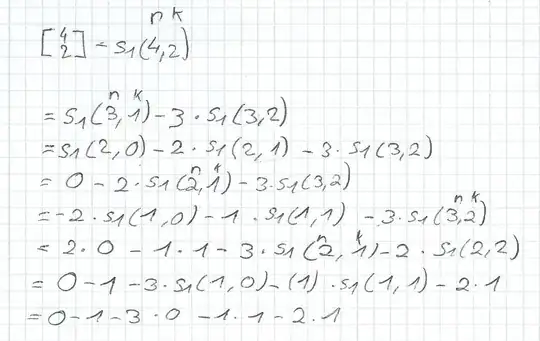You could use the rising factorial to find $\left[\begin{array}{c} 4 \\ 2 \end{array}\right]$. It goes as follows:
$$(x)^4 = x(x+1)(x+2)(x+3) = x^4 + 6x^3 + 11x^2 + 6x$$
$\left[\begin{array}{c} 4 \\ k \end{array}\right]$ is now the coefficient with $x^k$. Thus $\left[\begin{array}{c} 4 \\ 2 \end{array}\right]$ = 11.
For the recurrence relation with the unsigned Stirling numbers of the first kind, you would have:
$$\begin{align}
\left[\begin{array}{c} 4 \\ 2 \end{array}\right] & = 3\left[\begin{array}{c} 3 \\ 2 \end{array}\right] + \left[\begin{array}{c} 3 \\ 1 \end{array}\right]\\
& = 3\left(2\left[\begin{array}{c} 2 \\ 2 \end{array}\right] + \left[\begin{array}{c} 2 \\ 1 \end{array}\right]\right) + 2\left[\begin{array}{c} 2 \\ 1 \end{array}\right] + \left[\begin{array}{c} 2 \\ 0 \end{array}\right] = 6\left[\begin{array}{c} 2 \\ 2 \end{array}\right] + 5\left[\begin{array}{c} 2 \\ 1 \end{array}\right] + 0 \\
& = 6\left(\left[\begin{array}{c} 1 \\ 2 \end{array}\right] + \left[\begin{array}{c} 1 \\ 1 \end{array}\right]\right) + 5\left(\left[\begin{array}{c} 1 \\ 1 \end{array}\right] + \left[\begin{array}{c} 1 \\ 0 \end{array}\right]\right) = 6\left[\begin{array}{c} 1 \\ 2 \end{array}\right] + 11\left[\begin{array}{c} 1 \\ 1 \end{array}\right] + 0 \\
& = 6\left(0 + \left[\begin{array}{c} 0 \\ 1 \end{array}\right]\right) + 11\left(0\left[\begin{array}{c} 0 \\ 1 \end{array}\right] + \left[\begin{array}{c} 0 \\ 0 \end{array}\right]\right) = 11
\end{align}$$
For the recurrence relation with the signed Stirling numbers of the first kind, you would get:
$$\begin{align}
\mathrm{s}(4,2) & = -3 \mathrm{s}(3,2) + \mathrm{s}(3,1) \\
& = -3[-2\mathrm{s}(2,2) + \mathrm{s}(2,1)] -2\mathrm{s}(2,1) + \mathrm{s}(2,0) = 6\mathrm{s}(2,2) -5\mathrm{s}(2,1) + 0 \\
& = 6[-\mathrm{s}(1,2) + \mathrm{s}(1,1)] -5[-\mathrm{s}(1,1) + \mathrm{s}(1,0)] = -6\mathrm{s}(1,2) + 11\mathrm{s}(1,1) - 0 \\
& = -6[0 + \mathrm{s}(0,1)] + 11[0 + \mathrm{s}(0,0)] = 11
\end{align}$$
